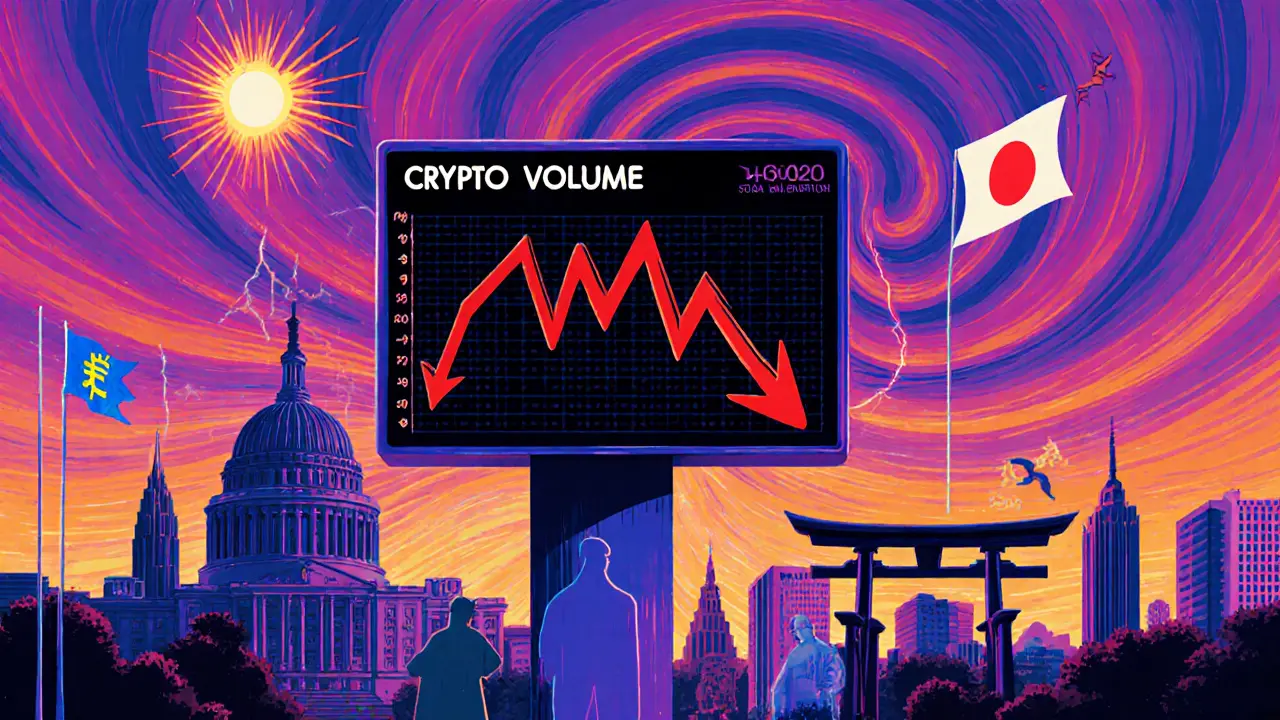Crypto Trading Volume Calculator
Volume Impact Calculator
Calculate how regulatory changes affect trading volume based on jurisdiction
Projected Volume After Regulation
Why the market suddenly hissed
Cryptocurrency regulatory restrictions is a set of government rules that limit how digital assets can be traded, listed, or used on exchanges. When those rules hit in 2023, 2024 and now 2025, the numbers on every exchange screen started to wobble. The headline crypto trading volume decline isn’t a random dip-it lines up with new licensing mandates, stable‑coin back‑ing rules, and compliance checklists that forced platforms to pull assets or lock users out.
What the data actually says
Across the last three years, the average quarterly drop in spot‑trading volume for the biggest centralized exchanges ran between 10 % and 27 %. SQ Magazine reported that after a regulatory announcement, volume fell 10‑25 % within the first 30‑90 days in the affected region. CoinGecko’s Q2 2025 report showed a stark -27.7 % QoQ dip, taking total spot volume from $5.4 trillion to $3.9 trillion despite Bitcoin hitting a new price high.
Regional snapshots: where the pain was strongest
Not every corner of the globe felt the same squeeze. In the United States, the mid‑2025 GENIUS Act requires stablecoins to be fully backed 1‑to‑1 with U.S. dollars led to an average 18.7 % volume dip in the first quarter of implementation. Crypto.com, trying to stay fully compliant, saw its quarterly volume tumble 61.4 % - from $560.2 billion to $216.4 billion.
Meanwhile, Japan and Switzerland, with clearer licensing paths, only slipped about 7 % on average. The European Union’s MiCA framework introduces a harmonised set of crypto rules for EU members limited its average contraction to roughly 12 %.
India and several European markets with rapidly shifting rules suffered the deepest hits - over 22 % average loss.
Exchange case studies: winners and losers
| Jurisdiction | Regulatory Trigger | Avg. Volume Change |
|---|---|---|
| United States | GENIUS Act | -18.7 % |
| European Union | MiCA | -12.3 % |
| Japan | Licensing Clarity | -7.3 % |
| Switzerland | FINMA Guidelines | -6.9 % |
| India | Tax & Reporting Rules | -22.1 % |
| Canada | Provincial AML Updates | -15.4 % |
Among the survivors, MEXC, HTX and Bitget actually grew QoQ, adding 3‑5 % volume by moving operations to friendlier jurisdictions.
What users felt on the ground
Reddit threads from May 2025 show U.S. traders watching their Crypto.com balances shrink overnight. One user, “CryptoTrader87”, noted a 60 % volume plunge after the exchange enforced the GENIUS Act’s token delistings. Trustpilot scores for major exchanges fell an average 1.8 points in Q1 2025, with complaints about “extra verification steps” and “sudden market access bans”.
Conversely, Swiss and Singapore users praised the new safeguards. A Reddit post by “SwissCryptoInvestor” recorded an initial 15 % volume dip that later turned into a 22 % gain once confidence returned.

The big players behind the numbers
CoinGecko provides market data and analytics for crypto assets supplied the quarterly volume figures. Chainalysis tracks crypto transaction flows worldwide highlighted the $2 trillion monthly transfer volume in North America and the surge of EURC stablecoins under MiCA.
TRM Labs offers crypto crime and compliance intelligence documented the drop of illicit volume from 0.9 % to 0.4 % of total traffic, linking that success to stricter rules.
Even the flagship asset, Bitcoin the original cryptocurrency, often used as a market bellwether, rose 30 % in Q2 2025 while overall exchange activity fell - a clear sign of “price‑up, volume‑down” dynamics caused by regulation.
Why stablecoins matter in the volume story
Stablecoins dominate daily transfer volume. USDT processed over $1 trillion each month and USDC ranged between $1.24 trillion and $3.29 trillion. Under MiCA, euro‑referenced stablecoins like EURC grew 79 % month‑over‑month, proving that clear, compliant pathways can actually boost a niche segment even when the broader market contracts.
Long‑term outlook: contraction or correction?
Analysts at JPMorgan predict an extra $1.4 trillion of dollar demand from stablecoins by 2027, assuming regulations keep improving. Galaxy Digital’s Dr. Alex Thorn says the current volume dip is the “clearest evidence” that fragmented rules are pulling capital into regulated vehicles like crypto ETFs, which saw $5.95 billion of inflows in a single week.
Critics such as Preston Byrne warn that overly prescriptive rules could push users to offshore platforms, threatening the market’s stability. Yet the data shows illicit activity shrinking and institutional confidence rising, hinting that the short‑term pain might be a maturation cost.
CoinGecko projects a return to volume growth in Q1 2026 once the GENIUS Act and MiCA are fully operational. The consensus among market makers is that the steepest declines will level off by Q4 2025 as exchanges finish their regulatory relocations.
What traders can do now
- Map where your favorite exchange is licensed. If it’s in a jurisdiction with clear rules (e.g., EU under MiCA), expect fewer sudden freezes.
- Consider diversified exposure: keep some assets on compliant platforms, and a smaller portion on peer‑to‑peer networks if you need flexibility.
- Watch regulatory calendars. Major announcements usually trigger a 10‑25 % volume swing within 30‑90 days.
- Use stablecoins that have a clear compliance path (USDC, EURC) to avoid delistings.
- Track institutional inflows via crypto‑ETF data - they often rise when exchange volume falls.
Bottom line
Regulatory restrictions have undeniably stamped a -27.7 % quarterly shock onto global crypto trading volume, even as prices kept climbing. The effect isn’t uniform: clear rules in places like the EU and Switzerland soften the blow, while aggressive U.S. legislation creates the deepest cuts. Users feel the squeeze in verification hurdles, but they also enjoy lighter fraud exposure. The market appears to be entering a “regulation‑adjusted” era where volume may settle at a lower baseline, but healthier, more transparent activity could drive growth beyond 2026.
Why did crypto trading volume drop even when prices rose?
New rules forced exchanges to delist tokens, tighten KYC, and limit cross‑border flows. Traders stayed on the sidelines, so volume fell while bullish price momentum continued.
Which jurisdictions saw the smallest volume decline?
Japan, Switzerland and the EU (under MiCA) all recorded declines under 12 %, thanks to clear licensing pathways.
How did the GENIUS Act affect U.S. exchanges?
The Act’s one‑to‑one backing rule made many stablecoins non‑compliant, leading to a roughly 18.7 % drop in overall U.S. exchange volume and a dramatic 61 % fall for Crypto.com.
Are stablecoins still a good place to park funds?
Yes, especially those with clear regulatory backing like USDC and the EU‑approved EURC, which saw rapid growth despite the broader market dip.
What should traders watch for in the coming months?
Regulatory calendars, exchange licensing locations, and stablecoin compliance updates. Those signals usually precede the next volume swing.

Write a comment